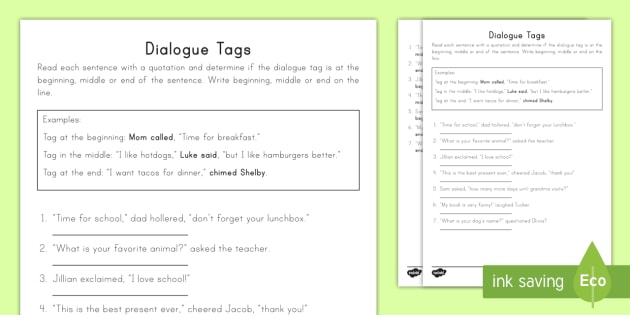

“This is not your concern,” Emma said angrily. Readers are being told how a character feels, as opposed to the words themselves showing what is happening. The problem with these types of tags is they are all tell. They are those ‘–ly’ adverbs used to convey emotion and tone. The purpose of dialogue tags is to identify the speaker, not to draw attention to the writer’s broad vocabulary or their limitless ability to consult with a thesaurus.Īn adverbial dialogue tag is when an adverb modifies the verb used. However, if they are used in every sentence during a section of dialogue, then they will most definitely cease to be invisible.Īs a writer, you never want your conversations to stand out and distract, confuse, or slow the read. Often times both ‘said’ and ‘asked’ are overlooked by readers, becoming invisible as they act out the conversations in their heads.Īs long as ‘said’ and ‘asked’ are not overused, (repeated in every paragraph of dialogue) they will definitely fade into the background. They serve the purpose without distracting from what is being said. These are the most common tags, and simply let the reader know who is talking. End the dialogue tag with appropriate punctuation.Īll the examples given up until this point have focused on using ‘said’ or ‘asked’ as part of the dialogue tags.Punctuation goes inside quotation marks.Therefore, making the quote the focal point of the sentence. Most often you will likely place your dialogue tag after the quote. When it is two sentences, the first sentence will end with a period and the second begins with a capital letter.End the dialogue with the appropriate punctuation keeping it inside the quotation marks.Unless the dialogue tag begins with a proper noun, it is not capitalized.


A comma is used after the dialogue tag, outside of quotation marks, to reintroduce it.When it is one continuous sentence, a comma is used before the dialogue tag and goes inside quotation marks.“I thought you cared.” Emma said, hoping to provoke him. “I thought you cared,” Emma said, “how could you let her leave?” In both cases, this signifies a pause your character takes. The tag can also be used to separate two sentences. End the dialogue with the appropriate punctuation and keep punctuation within the quotation marks.ĭialogue can be interrupted and then resumed in the same sentence.If the dialogue is the beginning of a sentence, capitalize the first letter.Placing her hands on her hips, Emma said, “I doubt you know more than I do!” Rising slowly from her chair, Emma asked, “Are we sure about this plan?” (UK English uses a different set of punctuation rules.) #1 – Tag Before the DialogueĪdding a tag in the beginning means that the character who is speaking is introduced before the actual quote. In this article we shall be following the rules for standard American English.

Commas go in particular places, as do terminal marks such as periods, exclamation points, and question marks. The rules for punctuating dialogue and associated tags are quite precise. The dialogue tag is the telling part of the sentence, while the actual dialogue used is the showing.ĭialogue tags can be found in three places: either before the dialogue, in-between the actual dialogue, or after.
#Example of dialogue tags how to#
How to use Dialogue Tagsĭialogue sentences are made of two parts: the dialogue, which is the spoken portion of the sentence, and then the dialogue tag, which identifies the speaker. However, dialogue tags can, of course, go beyond ‘said’ and ‘asked’ – we will get to that a bit later.įirst, let’s discuss how to properly utilize them in a written conversation. The words ‘said’ and ‘asked’ are the most obvious and the most used tags. Tags can, and for the most part, should be basic and simple. Writers can also use them for: mimicking the natural rhythms in speech, breaking up long pieces of dialogue and making them more digestible, maintaining, elevating or break tension. The main use of those is to keep characters straight for the reader. The phrase ‘Emma asked’ is the dialogue tag in the sentence. These small phrases indicate speech, telling the reader exactly who is speaking. Their function is to attribute written dialogue to a particular character. They are markers, little sentence clauses that follow the spoken words and act like a signpost for the reader.


 0 kommentar(er)
0 kommentar(er)
